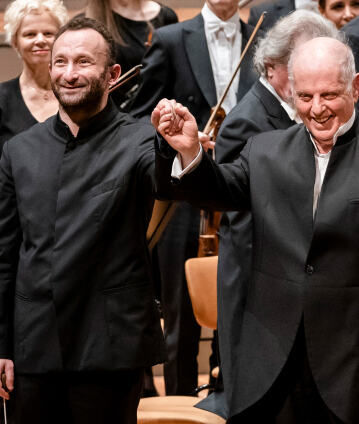Kirill Petrenko and Daniel Barenboim

Kirill Petrenko, the new man at the head of the Berliner Philharmoniker, encounters a decades-long friend of the orchestra: Daniel Barenboim. Together, they present Beethoven’s Piano Concerto No. 3, whose appeal lies in its self-assured showmanship and distinctive C Minor colouring. The music of Josef Suk, which has received far too little attention, is also a matter close to Kirill Petrenko’s heart. Here we hear his Second Symphony, an expressive work full of pain and sonority.
In his Third Piano Concerto, Beethoven knew how to triumphally stage the pianist (himself, that is). After 111 orchestral bars, the piano begins with what could be called an imperious demonstration of power, as the soloist spans the whole keyboard in three run-ups, then practically gouges the main theme into the keys, forte and unisono: a show of manual strength with piled-up octaves, followed at once, admittedly, by an introspective piano reflection. The playful dialogue of Baroque concertizing is transformed here into existential seriousness: a matter of self-assertion and of unyielding subjectivity. Kirill Petrenko programmed this third Beethoven concerto with Daniel Barenboim as the soloist. His playing is characterised by a profound understanding of the score, a concentrated kind of music making that always remains open for the orchestra’s developments.
After the intermission, the orchestra will play the Second Symphony – Asrael – by Czech composer Josef Suk; from an early stage, Kirill Petrenko has incorporated Suk’s orchestral works into his repertoire. Suk, pupil and son-in-law of Antonín Dvořák, developed into one of the most significant Czech composers of the dawn of modernism. As performing musician, he was the second violinist of the world-famous Czech String Quartet, playing more than 4,000 concerts in 20 European countries with the ensemble.
His Asrael Symphony, circling around the themes of grief, death and transfiguration, is named after the angel of death in Islamic and Jewish mythology; it was composed after two severe blows of fate: just 14 months apart, first Dvořák and then his daughter, Suk’s young wife Otylka, died unexpectedly. Sighing motifs and lamento figures pervade the work, which at times is reminiscent of Gustav Mahler’s symphonies in terms of its power of expression (and its division into two longer sections), as does a “speaking” sound symbol associated with death, which Suk took from his melodrama Radúz a Mahulena. In the second movement, in turn, the striking central motif from Dvořák’s Requiem is quoted. After a danse macabre, noticeably influenced by Tchaikovsky’s symphonic scherzi, part two begins, the introductory Adagio of which is dedicated to the memory of Otylka. The fifth and last movement finally culminates in a true “per aspera ad astra”. “Do you understand,” Suk wrote to his friend Otakar Šourek, “what I had to go through before I got to the closing C major? No, that isn’t just a work of pain; it is a work of superhuman energy.”
© 2020 Berlin Phil Media GmbH
Related interviews
Artists
Our recommendations
- “Welcome among us”: Concert for fugitives and helpers
- UNICEF concert for Japan with Simon Rattle and Daniel Barenboim
- Simon Rattle and Daniel Barenboim play Brahms
- A “St Petersburg Night” with Daniel Barenboim and Zubin Mehta at the Waldbühne
- 1994 Europakonzert from Meiningen with Claudio Abbado and Daniel Barenboim
- Claudio Abbado and Daniel Barenboim with Beethoven and Brahms